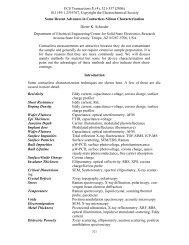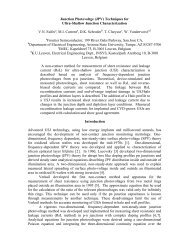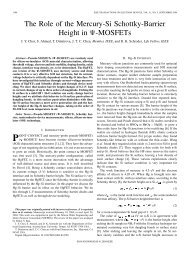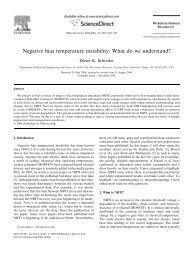Carrier Lifetimes in Silicon - Dieter Schroder - Arizona State University
Carrier Lifetimes in Silicon - Dieter Schroder - Arizona State University
Carrier Lifetimes in Silicon - Dieter Schroder - Arizona State University
Create successful ePaper yourself
Turn your PDF publications into a flip-book with our unique Google optimized e-Paper software.
SCHRODER: CARRIER LIFETIMES IN SILICON 161<br />
by lattice vibrations or phonons, illustrated <strong>in</strong> Fig. 2(a). The<br />
SRH lifetime is given by [2]<br />
where and are the equilibrium hole and electron densities,<br />
and are the excess carrier densities taken to be<br />
equal <strong>in</strong> the absence of trapp<strong>in</strong>g, and and are<br />
def<strong>in</strong>ed as<br />
(2)<br />
(3a)<br />
(3b)<br />
Dur<strong>in</strong>g radiative recomb<strong>in</strong>ation ehps recomb<strong>in</strong>e directly<br />
from band to band with the energy carried away by photons<br />
shown <strong>in</strong> Fig. 2(b). The radiative lifetime is [5]<br />
Fig. 1.<br />
(a)<br />
(b)<br />
(a) Forward-biased and (b) reverse-biased junction.<br />
(a) (b) (c) (d)<br />
Fig. 2. Recomb<strong>in</strong>ation mechanisms: (a) SRH, (b) radiative, (c) direct Auger,<br />
and (d) trap-assisted Auger.<br />
II. RECOMBINATION LIFETIME<br />
The recomb<strong>in</strong>ation rate depends nonl<strong>in</strong>early on the departure<br />
of the carrier densities from their equilibrium values. We<br />
consider a p-type semiconductor and are chiefly concerned<br />
with the behavior of the m<strong>in</strong>ority electrons. For a semiconductor<br />
device conta<strong>in</strong><strong>in</strong>g a pn junction we are concerned with the<br />
quas<strong>in</strong>eutral regions when discuss<strong>in</strong>g recomb<strong>in</strong>ation and the<br />
space-charge region when discuss<strong>in</strong>g generation. Three ma<strong>in</strong><br />
recomb<strong>in</strong>ation mechanisms determ<strong>in</strong>e the recomb<strong>in</strong>ation lifetime:<br />
1) Shockley–Read–Hall or multiphonon recomb<strong>in</strong>ation<br />
characterized by the lifetime ;2)radiative recomb<strong>in</strong>ation<br />
characterized by ; and 3) Auger recomb<strong>in</strong>ation characterized<br />
by These three recomb<strong>in</strong>ation mechanisms are<br />
illustrated <strong>in</strong> Fig. 2. The recomb<strong>in</strong>ation lifetime is determ<strong>in</strong>ed<br />
by the three mechanisms accord<strong>in</strong>g to the relationship<br />
[5]<br />
Dur<strong>in</strong>g SRH recomb<strong>in</strong>ation, electron-hole pairs recomb<strong>in</strong>e<br />
through deep-level impurities, characterized by the impurity<br />
density energy level <strong>in</strong> the bandgap, and capture cross<br />
sections and for electrons and holes, respectively. The<br />
energy liberated dur<strong>in</strong>g the recomb<strong>in</strong>ation event is dissipated<br />
(1)<br />
is usually termed the radiative recomb<strong>in</strong>ation coefficient.<br />
We <strong>in</strong>clude <strong>in</strong> both the radiative recomb<strong>in</strong>ation coefficient<br />
and the trap-assisted Auger coefficient with<br />
Even though trap-assisted Auger recomb<strong>in</strong>ation,<br />
shown <strong>in</strong> Fig. 2(d), is not a radiative event, we <strong>in</strong>clude it here<br />
because it has the same carrier density dependence as radiative<br />
recomb<strong>in</strong>ation. For Si, cm s and ranges<br />
from to cm s [6]. The radiative lifetime is<br />
<strong>in</strong>versely proportional to the carrier density because <strong>in</strong> bandto-band<br />
processes both electrons and holes must be present<br />
simultaneously for a recomb<strong>in</strong>ation event to take place.<br />
Dur<strong>in</strong>g Auger recomb<strong>in</strong>ation, illustrated <strong>in</strong> Fig. 2(c), the<br />
recomb<strong>in</strong>ation energy is absorbed by a third carrier. Because<br />
three carriers are <strong>in</strong>volved <strong>in</strong> the recomb<strong>in</strong>ation event, the<br />
Auger lifetime is <strong>in</strong>versely proportional to the carrier density<br />
squared. For a p-type semiconductor, the Auger lifetime is<br />
given by [5]<br />
where is the Auger recomb<strong>in</strong>ation coefficient.<br />
The recomb<strong>in</strong>ation lifetime accord<strong>in</strong>g to (1) is plotted <strong>in</strong><br />
Fig. 3. At high carrier densities, the lifetime <strong>in</strong> Si is controlled<br />
by Auger recomb<strong>in</strong>ation and at low densities by multiphonon<br />
recomb<strong>in</strong>ation. Radiative recomb<strong>in</strong>ation plays almost no role<br />
<strong>in</strong> Si, but is important <strong>in</strong> direct bandgap semiconductors<br />
like GaAs. The Auger lifetime appears to be described by<br />
more than one Auger coefficient. The data of Fig. 3 can be<br />
reasonably well fitted with cm s or<br />
cm s The reason for this discrepancy is not<br />
clear.<br />
When do these three lifetimes apply? SRH recomb<strong>in</strong>ation<br />
takes place whenever there are impurities or defects <strong>in</strong> the<br />
semiconductor. S<strong>in</strong>ce semiconductors always conta<strong>in</strong> some<br />
impurities, this mechanism is always active. It is particularly<br />
important for <strong>in</strong>direct bandgap semiconductors. The SRH<br />
lifetime depends <strong>in</strong>versely on the density of recomb<strong>in</strong>ation<br />
centers and capture cross sections but does not depend directly<br />
on the energy level of the impurity. It does depend <strong>in</strong>directly<br />
(4)<br />
(5)








